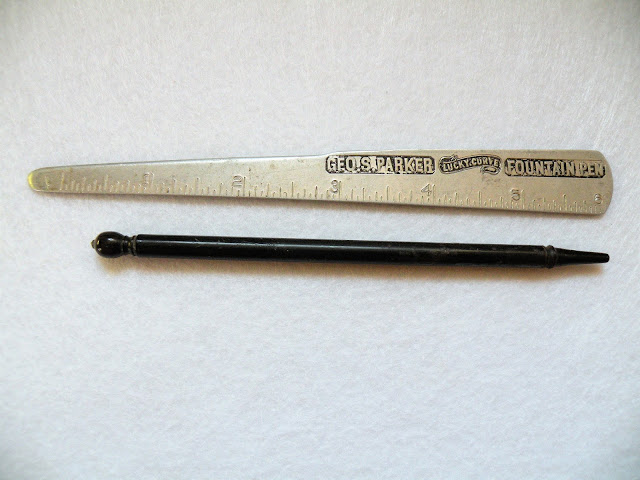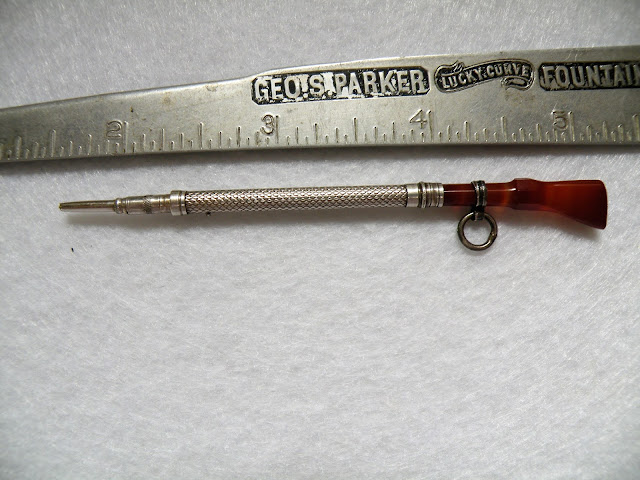The Tonnel Jewelry Company of Paris, France created this fleur-de-lis design mechanical pencil. Material is sterling silver. Circa 1880 - 1895. The piece extends and retracts for use and storage. Dimensions are 2 3/4 inches closed, 4 1/4 inches extended and 3/4 inches across.
Total Pageviews
Sunday, December 27, 2020
Monday, December 21, 2020
I'm showing today a nicely made black hard rubber mechanical pencil. Possibly made by the Day Company. Circa 1850 - 1860. What I found irresistible is that the pencil was dug out of the ground by a bottle collector. It was found in an 1875-1885 trash pit - while searching for his particular treasure. If this piece were free of cracks, dents, significant scratches, personalization and was in working condition it'd fit right in to my collection. As it is - with a bit of a roughed surface, scratches and frozen mechanism - it's a great personal find. Call it an artifact. 😀
Sunday, December 20, 2020
Saturday, November 21, 2020
Saturday, July 4, 2020
Today I'm showing two metal figural mechanical pencils represented as croquet mallets. The top piece is by Sampson Mordan of England. The lower unit is an unmarked no name. It was also likely produced in England. Both are circa 1880'ish. The Mordan tip is deployed by a front twist mechanism to propel and repel. The no name deploys via a channel attached collar - pushing the tip unit in and out for use.
Saturday, June 27, 2020
A Victorian combination cedar holder and stamp roll dispenser is a bit uncommon.This piece is hallmarked A.M Co and also marked Sterling Silver. My books were no help in identifying the company name via the printed hallmark. It was likely produced in America or England during the last half of the 19th century. Stamp roll dispensers were not uncommon to the era. Single purpose cedar holders were common. After installing a roll of stamps, the cap on this one turns to push the stamps out of the body slot (even works in reverse). Cedar holders feature a held wooden pencil that is driven in and out to the writing position by an attached exterior push / pull collar. The installed shown stamps are not correct to the period (issued much later). The combo length is 4 1/4 inches.
Sunday, June 14, 2020
Tuesday, June 9, 2020
In 1958 Waterman's closed it's factory in the United States. Manufacturing and administration moved to France. One theory goes that at that time unfinished hard rubber pencils, sitting around for as long as three decades, walked out with employees of the company. Pictured here are some of those pencils. Brand markings were applied as normal, but holes were never drilled for shirt clips or ring tops. Channels were not grooved for trim rings. I call these pencils blanks. Nevertheless, they look like they would have sold if offered. Nobody did hard rubber pencils like Waterman's did hard rubber pencils. Noooobody.
Sunday, May 24, 2020
Today I'm showing three mechanical pencils represented as life-size acorns. All are unmarked, likely made in England or America. Circa 1880 - 1895. All move the writing tip section in and out via a twist mechanism. The middle pencil nut features a built in stanhope at it's top.. Think of a stanhope as an optical lens installed on various objects - like a pencil, which displays a group of miniature pictures (typically beach or religious scenes). Measurement lengths are an average 1 3/8 inches closed and 1 1/2 inches ready to write.
Saturday, May 16, 2020
Today I'm posting about the Palmer Method of handwriting. To quote from Wikipedia: 'The Palmer Method of penmanship instruction was developed and promoted by Austin Palmer in the late 19th and early 20th centuries. It was largely created as a simplified style of the "Spencerian Method", which had been the major standardized system of handwriting since the 1840s.'
The Palmer Method was widely taught in the K12 school system up into the 1950's. The company produced the sales brochure showing below (likely dating to the second half of the 1920's). It features a shapely, ergonomically pleasant mechanical pencil. That curvish pencil style was popularized by the competition - Zaner-Bloser. Superimposed on the cover side of the brochure's pictures here is a later made Palmer Method pencil. That would be from my stash. Pencils marketed by the company were made for them by a third party mechanical pencil maker(s). The end. 😀
The Palmer Method was widely taught in the K12 school system up into the 1950's. The company produced the sales brochure showing below (likely dating to the second half of the 1920's). It features a shapely, ergonomically pleasant mechanical pencil. That curvish pencil style was popularized by the competition - Zaner-Bloser. Superimposed on the cover side of the brochure's pictures here is a later made Palmer Method pencil. That would be from my stash. Pencils marketed by the company were made for them by a third party mechanical pencil maker(s). The end. 😀
Saturday, May 9, 2020
Saturday, May 2, 2020
Inexpensive mechanical pencils were created during the 2nd half of the 19th century. Many were made of wood, hard rubber and cheaper metal materials. They were often very creatively executed, well made, and stylish. Some featured seriously unique and fascinating mechanisms. In other words, they were and remain quite likable. Simply - they worked. Pictured from the top showing are: an Eberhard Faber, Eberhard Faber, American Pencil Company, A. W. Faber, A. W. Faber, Eagle Pencil Co., Eagle, Eagle, and L & C Hardtmuth. All shown here were made in America with the exception of the Hardtmuth. The Hardtmuth was produced in what is now the Czech Republic. Yes, Faber's were produced in Germany and America.
Saturday, April 25, 2020
Showing today are three mechanical pencils represented as a cluster of canon. All are different. Circa 1880. From the top they are made by: 1.) likely Sampson Mordan and unmarked, 2.) Sampson Mordan and 3.) Fairchild. All are made of sterling silver (except the inner workings). The top piece features a manual pull telescopic section/writing tip. With the middle piece, a telescopic section/tip is driven out to writing position via a stiff spring. The smallest and lowest pictured pencil extends by pulling the back ring away from the body This action simultaneously forces the working section/tip out to the writing position.. Generically, this pull/push style is referred to as a magic pencil. Internal gearing supplies the actual magic. The longest pencil is 2 3/8 inches long closed and 4 inches ready to write. The smallest of the bunch measures 1 7/8 inches compacted and 2 15/16 inches deployed. Measurements do not include the stirrups and rings. Boom! 😀
Thursday, April 23, 2020
Physically it might appear we have a smokers pipe pictured here. Under closer examination it is a metal, combination traveling inkwell, dip pen and wooden pencil. The piece has no maker markings. Likely made during the 1890 -1915 period. Country of origin is probably England, possibly America. Material is of a very light gauge tin. yet the unit is still in remarkable condition. For the purists out there, the pen, or nib as it was later called, is not correct to the era of this piece. Smoke em if ya got em.
Monday, April 13, 2020
The Jif Company of France was founded in 1926. The company created their own distinct lines of mechanical pencils and fountain pens. Jif, also in cooperation with the American L.E. Waterman Company, took over Waterman's European production. Jif and Waterman pencils and pens were designed distinctly differently from each other. Some color patterns were shared between the two companies. I'm showing today a small group of Jif mechanical pencils. Circa 1926 thru possibly as late as the early '40's. Thank you Janet Wright and Jon Veley for the awesome pictures.
Sunday, March 29, 2020
Three birds of a feather. All are inexpensive, silver finished mechanical pencils made in the United States and England. Circa 1890 - 1915. The top piece was likely sold as production by it's maker, the American Pencil Company. The Cuba and T.J & J. S Ltd. London pieces were likely freebies given away for the tourist trade and advertising.
Sunday, March 22, 2020
Chilton Pen Company (made in America), produced quality pens and pencils during the 1920's thru the '30's. Showing here are examples of some of their models. All are mechanical pencils. The far left pencil was sold as a Seth Crocker. Next to it is a Sears. Both were sub-brands of Chilton. Both brands were family names within the company. The company was founded in 1923 by Seth Chilton Crocker. Everybody have a grape day. 😀
Saturday, March 14, 2020
Two metal figural mechanical pencils showing today that were made in the shape of screws. Both made in England. The top piece was produced by Sampson Mordan. It features a one stage telescopic section. The lead is tip activated. The lower piece is a promotional pencil marked Newman & Field Ltd. of Birmingham. The N & F pencil was likely made for them as a giveaway to their better customers. Both items were produced in the 1880 - 1890 period. The Mordan length is 2 1/8 inches closed and 3 3/16 inches extended. The N & F length is a static 4 1/8 inches.
Saturday, March 7, 2020
Showing today are a pair of hexagonal sided German mechanical pencils. The top piece is Montblanc, produced in the mid-1920's and made of hard rubber. It features a correct Montblanc accommodation shirt clip. The lower pencil was made by Kaweco during the 1936 - 1945 period. The material on this one is plastic. Both pieces propel by twist action and are repelled manually. The Montblanc measures 5 1/2 inches capped and 5 3/16 inches minus cap. The Kaweco capped measures 4 inches and is 3 5/8 inches capless.
Monday, March 2, 2020
Today I'm showing five double ended mechanical pencils. From the top they are a Sheaffer's, Listo, Kaweco, L&C Hartdmuth and no name German pencil. The no name pencil features enameled ends and a perpetual calendar. The Listo is the shortest in length at 5 3/16 inches. The Kaweco is the longest of the bunch at 6 3/8 inches. Commonly featured lead colors were red, blue and black.
Saturday, February 22, 2020
I'm showing today a tray of wood grained mechanical pencils. All were likely made in England The pencil materials are mostly hard rubber. A few are made of the plastic material of the day. All were produced during the mid 1920's through the late 1940's The lead mechanisms are twist activated excepting for fourth position from the right. That pencil is top button activated. For sizing comparisons the display box is eight inches across by six inches in height Position second from the right features two like material containers for extra leads.
Saturday, February 15, 2020
I'm showing today two sterling mechanical pencils produced in the form of bugle musical instruments. Both circa 1880. Both deploy the writing tip by turning the mouthpiece clockwise and then after use counterclockwise. The pencil pictured on top was produced in Birmingham, England. The maker name is washed out. The lower piece was made in London, England by the firm of Swaine & Adeney. Each is approximately 3 3/4 inches long closed and 4 1/2 inches long extended.
Subscribe to:
Posts (Atom)

















































